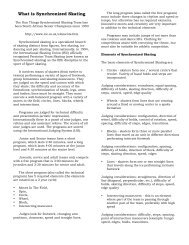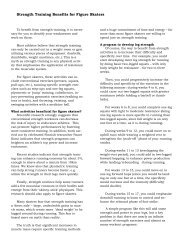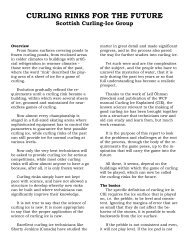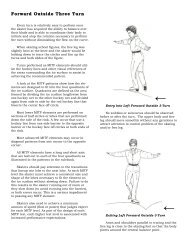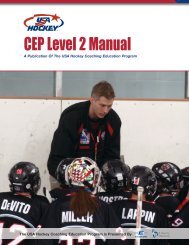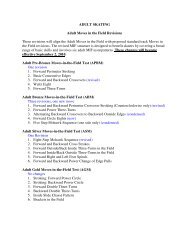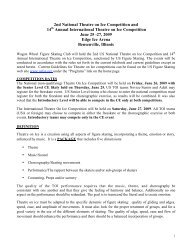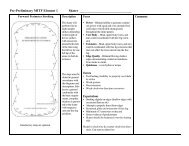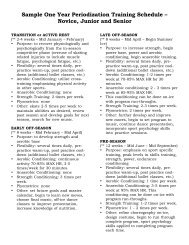CEP Level 3 Manual - Rushmore Hockey Association
CEP Level 3 Manual - Rushmore Hockey Association
CEP Level 3 Manual - Rushmore Hockey Association
Create successful ePaper yourself
Turn your PDF publications into a flip-book with our unique Google optimized e-Paper software.
T A B L E O F C O N T E N T Sthe net. Play the attacker and not the puck,and keep a good gap, (distance between youand the puck carrier), maintain same speedas forward, force player to backhand, do notcross your feet.• One-on-Two – The first defenseman who canplay the forward to his/her backhand sidemoves on the attacker and forces him/her tothe outside, therefore limiting his/her mobilityto one side of the ice. The seconddefenseman moves to back up his/herpartner and picks up the loose puck.• Two-on-One – Position yourself between thetwo forwards and try to force them off theshooting angle. Stay in the middle of the iceto prevent attempted passes. Never let thepuck carrier get behind you or cut in on thegoal. Keep the puck out of the prime scoringarea in front of the net. The defenseman’sprime responsibility here is to prevent thepass, force a bad angle shot, let the goalieplay the puck.• Two-on-Two – (No backcheckers) - play justlike the one-on-one, the defense does notcross if the forwards criss-cross, only playercoverage may change. Talk with your partnerand know your assignment. Protect themiddle of the ice, don’t allow the attackingforwards to split you or create a two-on-onesituation. Don’t back in too far on the goalie.Keep a tight gap, and try to prevent youropponents from gaining the blue line.• Three-on-One – (no backchecker) - stay inthe middle of the ice, try to stall or slowdown their attack, force a shot from a poorangle. Don’t become physically tangled withany of the attackers, avoid picks, interferenceand checks. Try to position yourself so thatthe puck carrier will have to pass the puckthrough you to reach a teammate. Don’tback in too far on your goaltender.• Three-on-Two – There can be two ways toplay this. (1) Try to force the play at the blueline with a one-on-one situation involving thepuck carrier and one defenseman. The otherdefenseman plays the open attackers(without puck) like a two-on-one, with theplayer closest to the net receiving the mostattention. (2) One defenseman plays thepuck carrier forward side establishing a twoon-onesituation, forcing the puck carrier tothe outside and a bad shooting angle. Theother defenseman plays a one-on-onesituation with the off-side attacker. Play adelaying game but threaten any puck carriercoming into the prime scoring area in front ofthe goal. Do not allow yourself to be drawnout of position.General Tips• Remember that the defensemen should bestaggered, and they must work together as apair.• Always gauge the speed of the attackerscoming at you. Your backward speed mustbe the same as the attacker’s speed.• When stick- or poke-checking never reachout so far that you are off balance — aforward can easily turn you if you haveshifted the wrong way.• Don’t body check when you are in asituation where the opposition has anumerical advantage. Check when you havean even or numerical advantage or the playerhas his/her head down.• Communicate with and back up yourteammates in your zone.• Blocking shots – (not recommended foryounger players) - if you have to block a shot,make sure the attacker is about to shoot---look for the clues, head drops, hand slipsdown the stick or he/she drops his/her armand shoulder on his/her shooting side. Donot drop too soon or the attacker will carrythe puck around you. Don’t commit yourselftoo early. Another method sometimes usedis the sliding block. The player must leavehis/her feet and slide the body in front of thepuck as close to the shooter as possible. Thismethod is very dangerous and must beperfectly timed. It should only be used byadvanced players.Defensive Zone Tips• Always try to stay between the puck carrierand the goal.• Coverage in the corner - move in undercontrol and force your opponents to go inthe direction you want them to move -cautiously play their body. Always create agood angle to eliminate the puck carrier’soptions.• Coverage in front of the net - block allopposing players out of the prime scoringarea, cover their sticks without losing sight ofthe puck, be prepared to intercept passes,clear rebounds and check opponentsattempting to shoot on goal. No one shouldbe left uncovered in this area. Defensemenshould stand off the goal posts facing up icewith a full view of the ice surface. Theyshould turn their heads, not their bodies,when looking into the corners and maintainphysical contact (use stick or arm, etc.) withthe opponent in the slot area. Don’t get intoa pushing and shoving match in front of thenet with an opponent who doesn’t have thepuck. Keep body position.Areas of ResponsibilityRDRWCDefense – The phase of the game during whichyour team is not in possession of the puck. It beginswhen your team loses possession of the puck andends when your team regains control of the puck.LWLDKey Elements1. Individual Skills• Checking the puck carrier, angling• Intercepting passes or cutting offpassing lanes• Covering opponent• Blocking shots2. Team Skills• Carrying out lane responsibilities inall three zones• Pressuring and outnumberingopponent at puck3. Defense is a Matter of Pride• Be proud of maintaining yourdefensive responsibilities4. Give 100 percent• Effort and energy are a matter of willDEFENSIVE RESPONSIBILITYCOVERAGEZONEBACKCHECKZONEFORECHECKZONECOffensive Zone – Forecheck1. Defensemen hold the blue line until the puckis between face-off dot and top of circle2. Middle defenseman plays as free safety,keeping all five of the opponents in front ofhim/herNeutral Zone – Backcheck1. Each defenseman plays the seam (imaginaryline drawn through face-off dots), to themiddle of the iceDefensive Zone – Coverage1. Force play to outside2. Strong-side defensemen on puck, block outpuck carrier from going to the net3. Weak-side defensemen cover the front of thenet, start on the weak-side post250 | USA <strong>Hockey</strong> Coaching Education Program <strong>Level</strong> 3 <strong>Manual</strong>Defensive Team Tactics | 251



